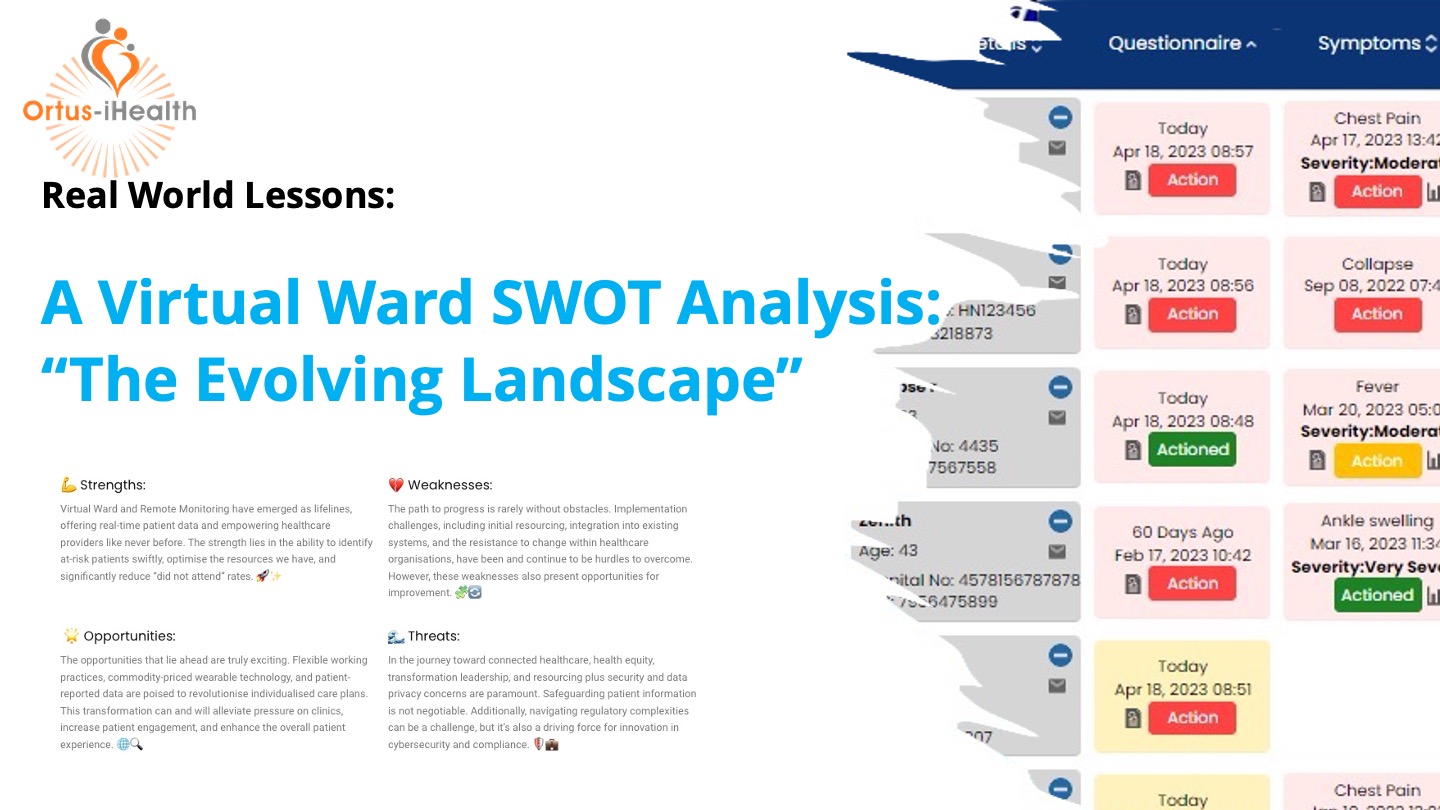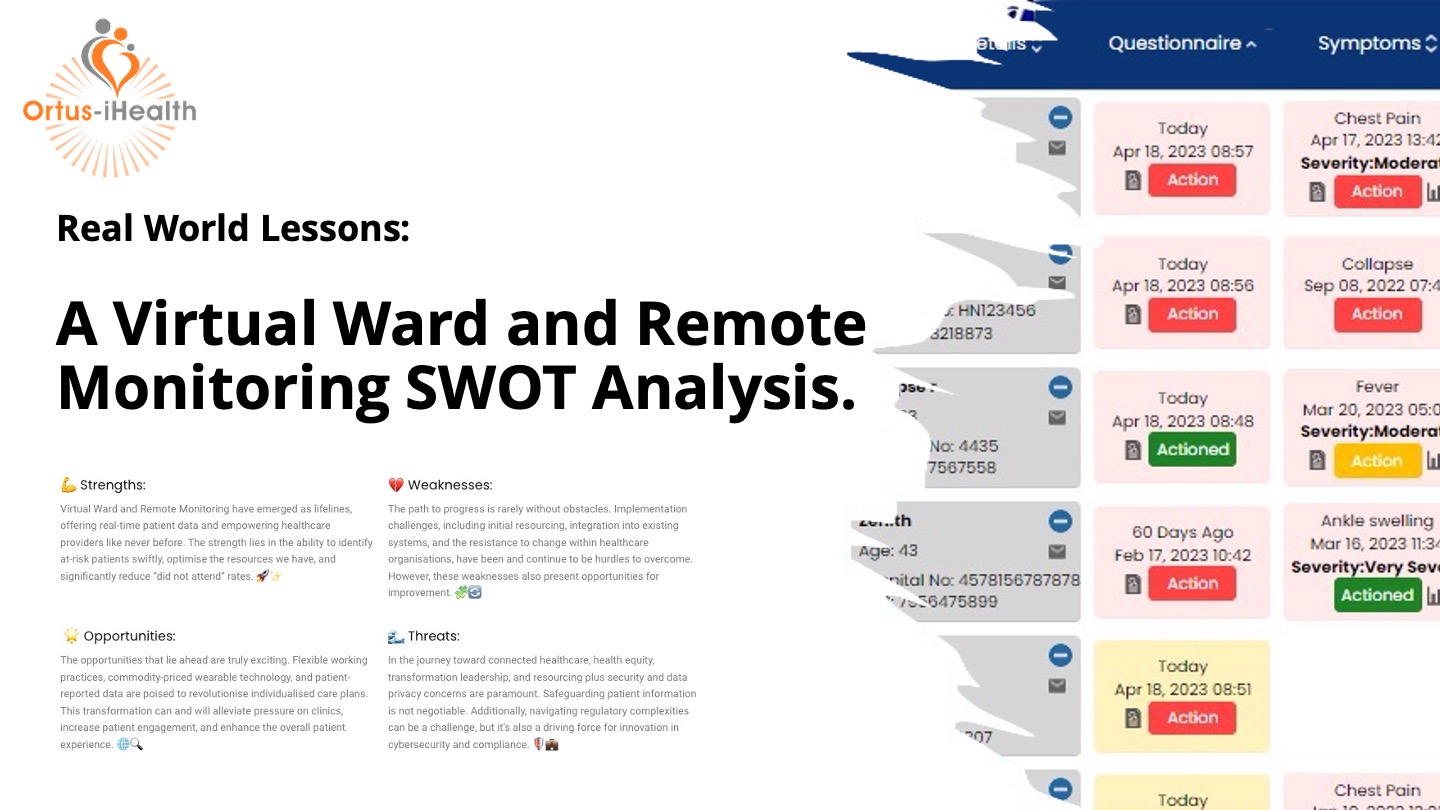Navigating Healthcare’s Future: A SWOT Analysis Part 3: The Evolving Landscape
The Evolving Landscape
In our exploration of Virtual Wards within the NHS, we’ve delved into a realm where significant strengths intersect with notable challenges. The strengths of Virtual Wards lie in their evidence-based approach, patient-centric care, the efficiency of multidisciplinary teams, and the innovative use of technology, all contributing to their scalability and cost-effectiveness. These elements collectively enhance both patient care and staff flexibility, positioning Virtual Wards as a transformative solution in healthcare.
Yet, this journey is marked by considerable challenges. Key among these are the hurdles in implementing Virtual Wards at scale, staffing challenges due to the need for specific digital skills, complexities in operational management, and concerns over maintaining the quality of care. These challenges, coupled with technological barriers and variable outcomes, raise pivotal questions about the long-term viability and effectiveness of Virtual Wards. The future trajectory of Virtual Wards, now seemingly shifting towards a greater emphasis on remote monitoring, invites further discussion and exploration.
As we anticipate the final part of our series, we consider the specific weaknesses and opportunities and encourage a continued dialogue around these innovative healthcare models.
🚧 Weaknesses:
1. Evidence of Implementation at Scale
2. Staffing Challenges
3. Complexity in Operational Managment
🚀 Opportunities:
1. National Policy Alignment
2. Scalability
3. Financial Efficiency
4. Integration with Existing Systems
Weaknesses
1 Evidence of Implementation at Scale
The implementation of Virtual Wards at scale presents a significant weakness, primarily due to the lack of comprehensive, large-scale evidence. While smaller studies and pilot programs have shown promise, there is a gap in evidence demonstrating the effectiveness of Virtual Wards across a broader, more diverse population. This lack of large-scale implementation data makes it challenging to assess the true impact and scalability of Virtual Wards, potentially hindering their widespread adoption and adaptation to various healthcare settings.
2 Staffing Challenges
Staffing presents a notable weakness in the deployment of Virtual Wards. The model requires a specific skill set, including proficiency in digital tools and remote patient monitoring, which may not be readily available in the current workforce. Additionally, the transition to Virtual Wards demands significant training and adaptation for existing staff, which can be resource-intensive. The challenge is further compounded by the ongoing healthcare workforce shortage, making it difficult to maintain adequate staffing levels to support the effective operation of Virtual Wards.
3 Complexity in Operational Managment
The complexity in operational management is another weakness of Virtual Wards. Managing these wards involves coordinating a range of activities, from patient monitoring to data analysis, and integrating them with existing healthcare systems. This complexity can lead to operational challenges, such as data management issues, difficulties in workflow integration, and challenges in maintaining consistent standards of care. These operational hurdles can impede the efficiency and effectiveness of Virtual Wards, affecting their overall performance and patient outcomes.
Opportunities
1 National Policy Alignment
The alignment of Virtual Wards with national healthcare policies presents a significant opportunity. By fitting seamlessly into the broader strategic goals set by healthcare authorities, Virtual Wards stand to benefit from supportive policy frameworks and potential funding opportunities. This alignment ensures that Virtual Wards are not just isolated initiatives but integral parts of a national effort to modernize and improve healthcare delivery, thereby increasing their chances of success and sustainability.
2 Scalability
Scalability is a key opportunity for Virtual Wards. Their digital nature allows for rapid expansion and adaptation to different patient populations and healthcare needs without the physical constraints of traditional hospital settings. This scalability means that Virtual Wards can be effectively used to manage a wide range of medical conditions, from chronic diseases to post-operative care, making them a versatile tool in the healthcare system’s arsenal.
3 Financial Efficiency
Virtual Wards offer considerable financial efficiency, which is a major opportunity in the context of rising healthcare costs. By reducing the need for physical hospital beds and enabling remote patient monitoring, Virtual Wards can significantly improve the return on investment of existing beds, increasing the effective utilisation. Additionally, they can decrease the length of hospital stays and reduce readmission rates, leading to further cost savings for healthcare systems and insurers.
4 Integration with Existing Systems
The opportunity for Virtual Wards to integrate with existing healthcare systems is a crucial advantage. This integration allows for a more cohesive and coordinated approach to patient care, ensuring that data and insights gained from Virtual Wards can inform and enhance other aspects of healthcare delivery. Seamless integration also means better continuity of care for patients, as their medical information can be easily accessed and shared among different healthcare providers.
To Conclude
Over the 3 posts we’ve reflected on the potentially transformative world of Virtual Wards, a series of intriguing questions and considerations emerge, shaping the future of hospital at home and wider forms of healthcare delivery. I’ve aimed in this post series has explored the multifaceted landscape of Virtual Wards, highlighting both the promising opportunities and the significant challenges they present.
Opportunities and Strengths: A New Horizon in Healthcare Virtual Wards are fundamental to national healthcare policies, presenting an opportunity to be at the forefront of healthcare innovation, but more importantly representing one of very few approaches available to support the growing demands of a growing and aging population. Their scalability is a game-changer, offering adaptability to various medical needs without the physical limitations of traditional settings. Financial efficiency stands out as a key benefit, while not reducing the baseline costs of health delivery it increases the capital efficiency of delivery potentially revolutionizing cost management in healthcare. Moreover, the seamless integration of Virtual Wards with existing healthcare systems promises a more cohesive patient care experience.
Challenges and Weaknesses: The Roadblocks to Innovation However, the journey is not without its hurdles. The implementation of Virtual Wards at scale remains a significant challenge, delays in the availability of funding has slowed the rate of deployment and delayed the collection of large-scale evidence of effectiveness. Staffing challenges, particularly the need for specific digital skill sets and adequate training, pose a critical barrier. Additionally, the complexity in operational management highlights the need for robust strategies to navigate data management and workflow integration.
The Balancing Act: Questions to Ponder As we reflect on these insights, several key questions arise:
- How can healthcare systems bridge the gap between the potential of Virtual Wards and the challenges in their implementation?
- What strategies are needed to effectively train and prepare healthcare staff for the transition to Virtual Wards?
- How can Virtual Wards be integrated into existing healthcare systems to maximize their benefits while minimizing disruption?
Looking Ahead: The Next Chapter in the Virtual Ward Journey
The future of virtual wards hangs in the balance with recent commitments being made to catch-up and a refocussing on virtual wards in 2024/25 with what appears to be a potential revisiting of the original strategies goals and ambitions and what would appear to be a shift towards a remote monitoring focus rather than the specifically 7 to 14 day virtual ward model. From politicians to policy makers, to the workforce and economic climate, there are many variables that will come into play and contribute to determining the exact journey ahead.
To conclude, with the evolving landscape of Virtual Wards, balancing their potential with the practical challenges they face, presents an opportunity for collective reflection and discussion. We invite you to share your insights and experiences as we navigate this evolving terrain destined to shape the future of healthcare delivery, please share your insights in the comments below! 👇🤝
Related Posts
Navigating Healthcare’s Future: A SWOT Analysis of Virtual Ward & Remote Monitoring in the UK NHS
A Virtual Ward and Remote Monitoring SWOT Analysis (Part 1 of 3) As professionals in the healthcare industry, we are witnessing a monumental shift in patient care. The adoption of Virtual Ward and Remote Monitoring technology within the UK NHS has been a game-changer. 🇬🇧💡 In my role at Ortus-iHealth, I’ve had the privilege of […]
Navigating Healthcare’s Future: A SWOT Analysis Part 2: Strengths and Threats!
A Virtual Ward and Remote Monitoring SWOT Analysis: Strengths and Threats (Part 2 of 3) In the first instalment of this three-part series, we touched on the transformative expectations and circumstances surrounding NHS England’s plans for the deployment of Virtual Wards. Programmes of this scale across an organisation as complex and diverse as the NHS [&h





Leave a Reply